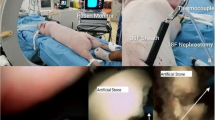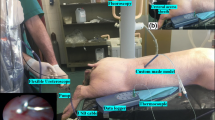Abstract
To compare the effect of MOSES™ modulation technology to conventional pulse delivery technology on the irrigation fluid temperature (IFT) under different irrigation conditions during flexible ureteroscopy (FURS) in a live-anesthetized porcine model. For this experiment was used one female pig. A percutaneous access was obtained and a 30Fr sheath was placed inside the upper calyceal system. A thermocouple was inserted through the sheath to the upper calyx to record the effect on IFT during FURS. A Lumenis 120H Ho:YAG laser was used and the IFT was recorded during laser activation for 30 s at a laser power of 20 W, 40 W and 60 W under gravity and manual pump irrigation using MOSES™ and conventional pulse delivery technology. In the highest power settings the maximum IFT was achieved in 18 s under gravity irrigation (66.4 °C). It seems that there is no significant difference on IFT between MOSES and conventional mode on the IFT under different irrigation conditions during FURS at 20 W, 40 W and 60 W power settings. Furthermore, our results indicate that under manual pumping even high-power settings (40 W, 60 W) can be performed with safety. In the in vivo model, the MOSES™ pulse delivery technology does not have a significant difference in the maximal IFT in comparison to conventional pulse delivery technology during FURS in the same power settings. Manual pumping should be used to keep the IFT within safe limits.




Similar content being viewed by others
Abbreviations
- FURS:
-
Flexible ureteroscopy
- IFT:
-
Irrigation fluid temperature
- Ho:YAG:
-
Holmium: yttrium–aluminum-garnet
- UAS:
-
Ureteral access sheath
References
Türk C, Petřík A, Sarica K, Seitz C, Skolarikos A, Straub M, Knoll T (2016) EAU Guidelines on interventional treatment for urolithiasis. Eur Urol 69(3):475–482. https://doi.org/10.1016/j.eururo.2015.07.041
Becker B, Gross AJ, Netsch C (2019) Ho: YaG laser lithotripsy: recent innovations. Curr Opin Urol 29(2):103–107. https://doi.org/10.1097/mou.0000000000000573
Elhilali MM, Badaan S, Ibrahim A, Andonian S (2017) Use of the Moses technology to improve holmium laser lithotripsy outcomes: a preclinical study. J Endourol 31(6):598–604. https://doi.org/10.1089/end.2017.0050
van Rhoon GC, Samaras T, Yarmolenko PS, Dewhirst MW, Neufeld E, Kuster N (2013) CEM43°C thermal dose thresholds: a potential guide for magnetic resonance radiofrequency exposure levels? Eur Radiol 23(8):2215–2227. https://doi.org/10.1007/s00330-013-2825-y
He X, McGee S, Coad JE, Schmidlin F, Iaizzo PA, Swanlund DJ, Kluge S, Rudie E, Bischof JC (2004) Investigation of the thermal and tissue injury behaviour in microwave thermal therapy using a porcine kidney model. Int J Hyperth 20(6):567–593. https://doi.org/10.1080/0265673042000209770
Liang H, Liang L, Yu Y, Huang B, Jn C, Wang C, Zhu Z, Liang X (2020) Thermal effect of holmium laser during ureteroscopic lithotripsy. BMC Urol 20(1):69. https://doi.org/10.1186/s12894-020-00639-w
Winship B, Wollin D, Carlos E, Peters C, Li J, Terry R, Boydston K, Preminger GM, Lipkin ME (2019) The rise and fall of high temperatures during ureteroscopic holmium laser lithotripsy. J Endourol 33(10):794–799. https://doi.org/10.1089/end.2019.0084
Hein S, Petzold R, Suarez-Ibarrola R, Müller PF, Schoenthaler M, Miernik A (2020) Thermal effects of Ho:YAG laser lithotripsy during retrograde intrarenal surgery and percutaneous nephrolithotomy in an ex vivo porcine kidney model. World J Urol 38(3):753–760. https://doi.org/10.1007/s00345-019-02808-5
Kallidonis P, Kamal W, Panagopoulos V, Vasilas M, Amanatides L, Kyriazis I, Vrettos T, Fligou F, Liatsikos E (2016) Thulium laser in the upper urinary tract: does the heat generation in the irrigation fluid pose a risk? Evidence from an in vivo experimental study. J Endourol 30(5):555–559. https://doi.org/10.1089/end.2015.0768
Noureldin YA, Farsari E, Ntasiotis P, Adamou C, Vagionis A, Vrettos T, Liatsikos EN, Kallidonis P (2021) Effects of irrigation parameters and access sheath size on the intra-renal temperature during flexible ureteroscopy with a high-power laser. World J Urol 39(4):1257–1262. https://doi.org/10.1007/s00345-020-03287-9
Guzelburc V, Balasar M, Colakogullari M, Guven S, Kandemir A, Ozturk A, Karaaslan P, Erkurt B, Albayrak S (2016) Comparison of absorbed irrigation fluid volumes during retrograde intrarenal surgery and percutaneous nephrolithotomy for the treatment of kidney stones larger than 2 cm. Springerplus 5(1):1707. https://doi.org/10.1186/s40064-016-3383-y
Stenberg A, Bohman SO, Morsing P, Müller-Suur C, Olsen L, Persson AE (1988) Back-leak of pelvic urine to the bloodstream. Acta Physiol Scand 134(2):223–234. https://doi.org/10.1111/j.1748-1716.1988.tb08483.x
Funding
All authors certify that they have no affiliations with or involvement in any organization or entity with any financial interest or non-financial interest in the subject matter or materials discussed in this manuscript.
Author information
Authors and Affiliations
Corresponding author
Ethics declarations
Conflict of interest
The authors have no relevant financial or non-financial interests to disclose.
Research involving animals
Ethics approval was obtained from the related state services and one female pig approximately 30 kg was used.
Additional information
Publisher's Note
Springer Nature remains neutral with regard to jurisdictional claims in published maps and institutional affiliations.
Rights and permissions
About this article
Cite this article
Peteinaris, A., Faitatziadis, S., Tsaturyan, A. et al. MOSES™ pulse modulation technology versus conventional pulse delivery technology: the effect on irrigation fluid temperature during flexible ureteroscopy. Urolithiasis 50, 613–618 (2022). https://doi.org/10.1007/s00240-022-01342-1
Received:
Accepted:
Published:
Issue Date:
DOI: https://doi.org/10.1007/s00240-022-01342-1




